D&D.Sci Pathfinder: Return of the Gray Swan Evaluation & Ruleset
post by aphyer · 2021-09-09T14:03:56.859Z · LW · GW · 13 commentsContents
RULESET MAP SHIPS CAPTAINS ADMIRALTY DOCTRINE ENCOUNTERS Harpies Iceberg Reef Kraken Dragon Sharks Merfolk Storm Wyrd Majick Fyre Pirates STRATEGY ROUTING Route to E8: Route to L13: SHIP SELECTION LEADERBOARD THE LARGE SECRET THOUGHTS AND FEEDBACK REQUEST None 13 comments
This is a followup to last week's D&D.Sci scenario [LW · GW]; if you haven’t already read it, you should do so now before spoiling yourself.
RULESET
Code used to generate the dataset is available here, with my apologies for the somewhat-spaghetti nature of it. The master voyage and encounter logs (including more detail and including destroyed ships) are available here and here.
MAP
The master map is:
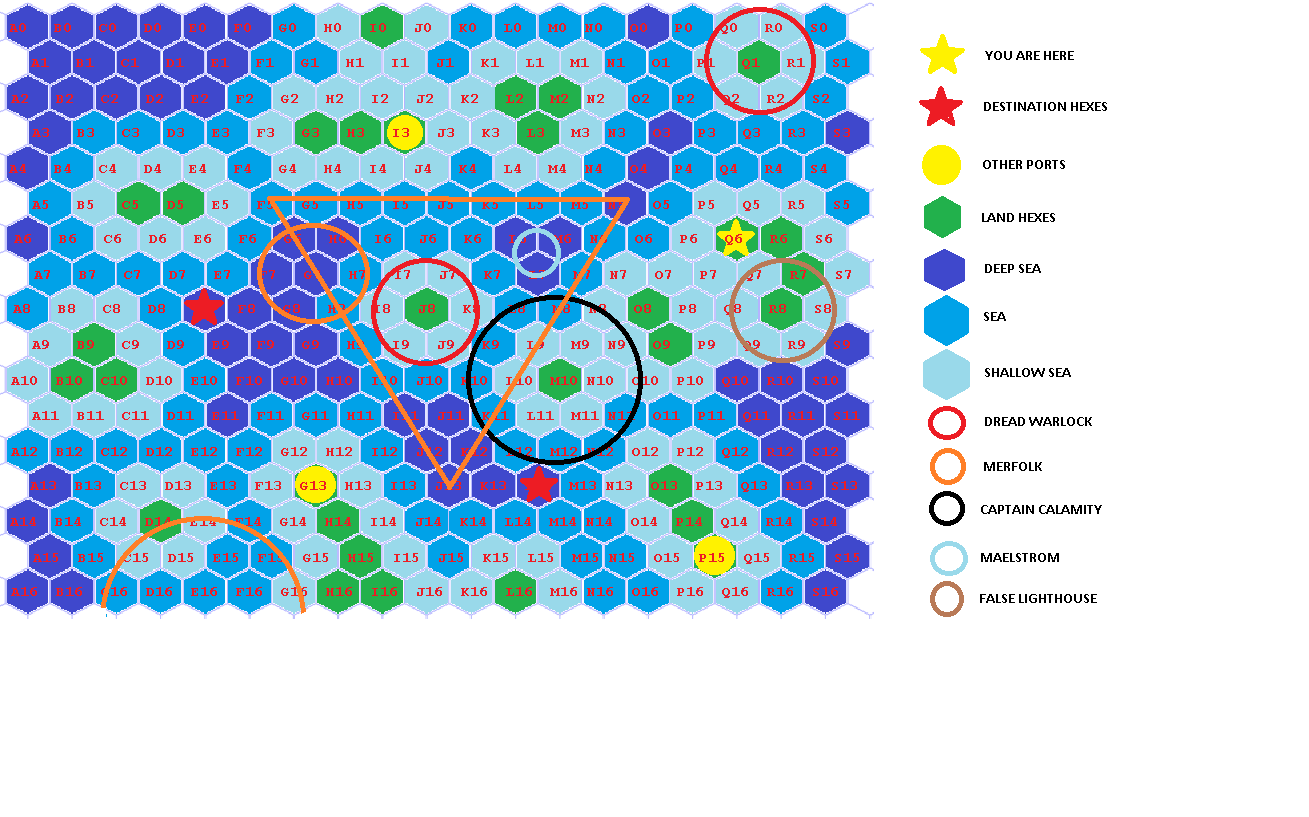
Features to note:
- Light Blue and Dark Blue show 'Depth' of water hexes. Water hexes adjacent to land are Shallow, and have more danger from e.g. Reefs. Water hexes very far from land (3 hexes or more) are Deep, and have more danger from e.g. Kraken.
- Orange=Merfolk. The circles are their attack ranges. The triangle is the migration route of Atlantean merfolk.
- Blue=the Maelstrom.
- Red=the Dark Warlock's towers.
- Black=Captain Calamity's Cove.
- Brown=False Lighthouse.
Note also that there is a secret island in hex L16. This island is not on the Admiralty maps. (Congratulations simon for noticing this in the data).
SHIPS
A ship has several relevant statistics:
| Ship | Hull | Guns | Speed | Size |
| Galleon | 30 | 4 | 1 | Large |
| Barquentine | 20 | 4 | 3 | Large |
| Carrack | 30 | 2 | 3 | Large |
| Dhow | 20 | 2 | 3 | Small |
A Dhow has generally poor stats but is Small. This gives it some protection from reefs and running aground, but more importantly means that the Admiralty tends to assign it to short voyages, and so its survival rate in the data is higher than it should be. My condolences to anyone tricked by this.
Hull is your effective HP. Damage done is a percentage of this - a Barquentine or Dhow that takes 4 damage will have taken 20% damage, while a Galleon or Carrack will only have taken 13.3% damage (rounded up to 14% in the Admiralty logs you saw). A Barquentine has low Hull, which makes it more vulnerable to encounters that directly damage Hull without interacting with Guns or Speed (e.g. Reefs, Icebergs).
Guns help defend you against certain encounters. A Carrack has low Guns, which makes it more vulnerable to encounters that need to be fought off (e.g. Krakens, Dragons, Harpies).
Speed helps you avoid certain encounters. A Galleon has low Speed, which makes it much more likely to have encounters that can be outrun (e.g. Pirates, Dragons).
CAPTAINS
A ship also has a Captain with one relevant stat, Seamanship, which ranges from 1-3. Within this dataset Captains are in a one-to-one relationship with ships: they are assigned to a ship when that ship is commissioned, and serve on it until it sinks, at which point they go down with the ship.
Seamanship is determined by rolling 2d3 and picking the lowest. However, all captains must graduate the Admiralty Naval Academy. A Captain with 1 Seamanship will fail (and you will roll a new captain), one with 2 Seamanship will pass 50% of the time, and one with 3 Seamanship will pass 100% of the time.
Half of all new Captains are Noble. (Nobles have names like 'Lord Friedrich von Walderdorf' rather than names like 'Angus MacDougal'). Nobles always pass the Academy with a gentleman's third, regardless of their Seamanship. From your perspective, this looks like Noble captains being much worse:
| Seamanship | Noble | Non-Noble |
| 1 | 56% | 0% |
| 2 | 33% | 60% |
| 3 | 11% | 40% |
(Through a process of evolution, Seamanship 1 captains tend to die more quickly, so their prevalence in the population is lower than this table might lead you to believe).
Seamanship has the following effects:
- Higher Seamanship gives large protection against Reefs (take less damage) and Icebergs (hit them less often).
- Higher Seamanship gives moderate protection against Storms (weather them better) and Pirates (outmaneuver them in combat).
- Seamanship 1 Captains (who are always Noble) have a small probability (1% per hex) of getting confused by the charts and those weird gold machines and steering into the wrong hex for their next move. This can lead to them having encounters off of their plotted course, or even briefly running aground.
ADMIRALTY DOCTRINE
Each week, the Admiralty behaves as follows:
- If there are <80 ships in circulation, build ships at random ports, up to a maximum of 4 new ships built (with a slight tendency to building ship classes that are rare at that port).
- Each port independently generates 1d4 voyages:
- Each voyage has a 50% chance to be a Cargo voyage, carrying one of that port's Cargo types to another port that does not export that Cargo type.
- It has a 50% chance to instead be a Scouting or Fishing voyage, heading out to a random location 3-5 hexes away from the start port and then returning to that port.
- If any port has >2x as many ships as another port, it generates an additional 'Transfer' voyage, sending a ship to that other port.
- Each voyage is assigned a ship:
- The Admiralty prefers to assign ships as follows:
- Only assign a ship that has been in port for at least 5 weeks, in order to ensure some time for repair.
- If the voyage is 6 or fewer hexes long, only assign a Small ship (a dhow).
- If the voyage is 9 or more hexes long, only assign a Large ship (not a dhow).
- If the Admiralty is unable to find a ship meeting these criteria for the voyage, they are equally likely (50% each) to:
- Cancel the voyage, or
- Assign it to a random ship that does not meet the criteria, and make that ship do the voyage anyway.
- The Admiralty prefers to assign ships as follows:
- Each voyage's route is planned by repeatedly moving to a random adjacent hex that brings you closer to your destination. The Admiralty will never plan a route that is not the shortest possible.
- After voyages are executed, each ship in port repairs 10% of its Hull.
- Yes, this means that ships do not always begin voyages at full Hull. Even if the Admiralty waits the full 5 weeks, this is not always enough time for a heavily damaged ship to be fully repaired.
- A ship that begins a voyage damaged will end the voyage with more damage than can be explained by its encounters.
ENCOUNTERS
Harpies
In any given hex, Harpies attack with default probability 10% divided by your ship's Speed (so 10% for a Galleon, 3.3% for any other ship).
Harpies love to steal and eat Magefruit. If you are carrying Magefruit as cargo, your Harpy encounter rate is quadrupled.
1d6 Harpies attack your ship at once. Your ship shoots down a number of them equal to its Guns. Then each surviving Harpy deals 1 damage to your ship.
If all Harpies were killed (and you took 0 damage), the Harpies are Afraid of you. For the rest of the journey, you will not have any more Harpy encounters.
Iceberg
An Iceberg is encountered with probability 50% in any Cold hex. (If this seems high, see the comment on logging below). By default, rows 0-6 are Cold. However, during Summer (June-August), only rows 0-2 are Cold, while during Winter (December-February), rows 0-10 are Cold. During your mission, it is Summer, and so Icebergs are not relevant to your voyage.
You roll d20 + Seamanship, and avoid the iceberg on a roll of 5 or higher. If you avoid it, you take no damage and do not bother to log it. If you fail to avoid it, you take d6 damage.
Reef
A Reef can be encountered in any hex that is adjacent to land (shallow water) but not adjacent to a port (those areas are well mapped out). In those hexes, a Reef is encountered with probability 20%.
- Dhows are small, and have 4/5 lower chance to hit a Reef.
- There is a False Lighthouse in hex R8. Adjacent to that hex, you are twice as likely to hit a reef and likely to take more damage.
When you hit a reef, you take 1 damage and are stuck on the reef. Then you roll a d8, and get off of the reef if you roll <= your Seamanship. (If you are adjacent to the False Lighthouse, you instead roll a d12). Repeat this until you have either escaped the reef or been destroyed.
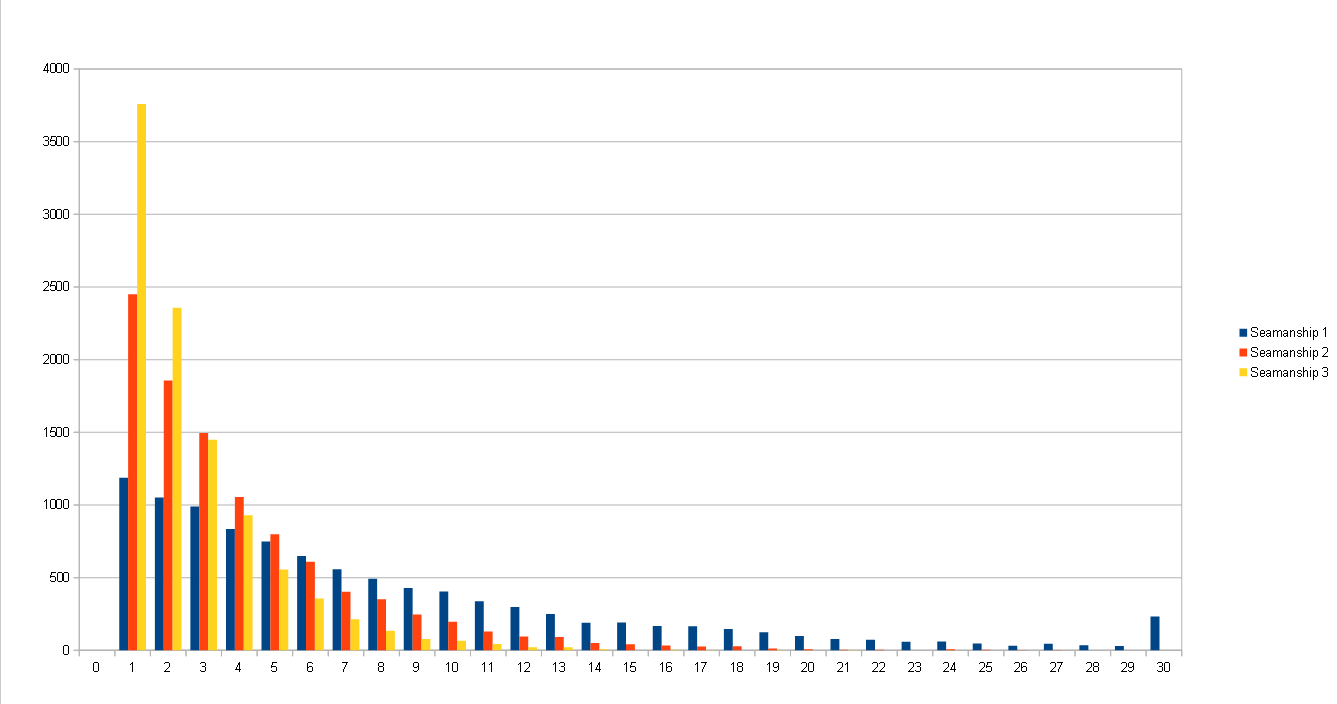
Reef damage falls off, with a long tail for low-Seamanship captains but usually pretty restrained damage for 2 or 3-Seamanship captains.
Kraken
A Kraken can be encountered in any hex not within 2 spaces of land (deep water). In those hexes, a Kraken is encountered with probability 30% (not modified by speed, you cannot tell the Kraken is there until it has grabbed you).
A Kraken starts the fight by rolling 2d6 for Tentacles. Each round, you reduce Tentacles by an amount equal to your Guns, then take 1 damage per remaining Tentacle, and then repeat. So if a Kraken rolls 7, a 4-gun ship will take 3 total damage (all in the first round), while a 2-gun ship will take 9 total damage (5 in the first round, 3 in the second, 1 in the third).
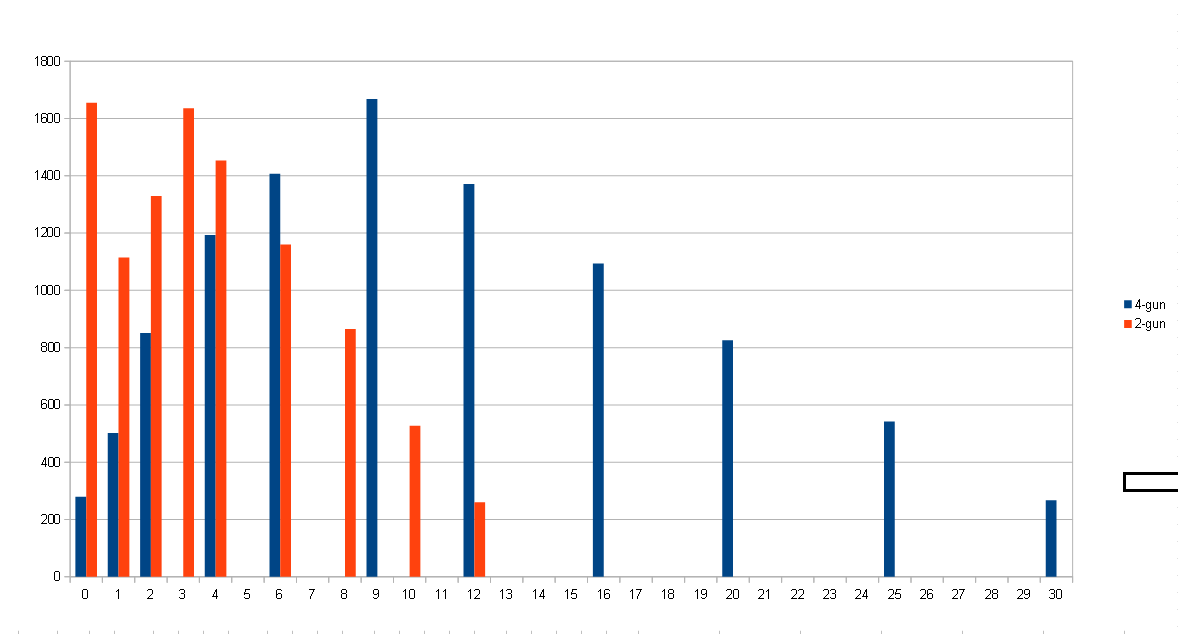
Overall Kraken damage is substantially higher on a 2-gun ship than a 4-gun ship.
Dragon
Dragons kill where they wish and none dare resist but fortunately you can shoot them. A Dragon can attack in any hex, with a probability of 2% divided by your Speed.
Dragons fight very similarly to Krakens - they start by rolling 2d6 for Fierceness, and then alternate between you reducing Fierceness by an amount equal to your guns and you taking damage equal to Fierceness.
The only difference is that, after each time a Dragon deals damage, it has a 1/3 chance of damaging one of your guns. That gun will not be usable for the rest of the fight. If a Dragon reduces you to 0 guns, it rips you apart at its leisure.
If you survive a Dragon fight, you are able to repair your guns afterwards, and they return to their original value for the rest of the voyage.
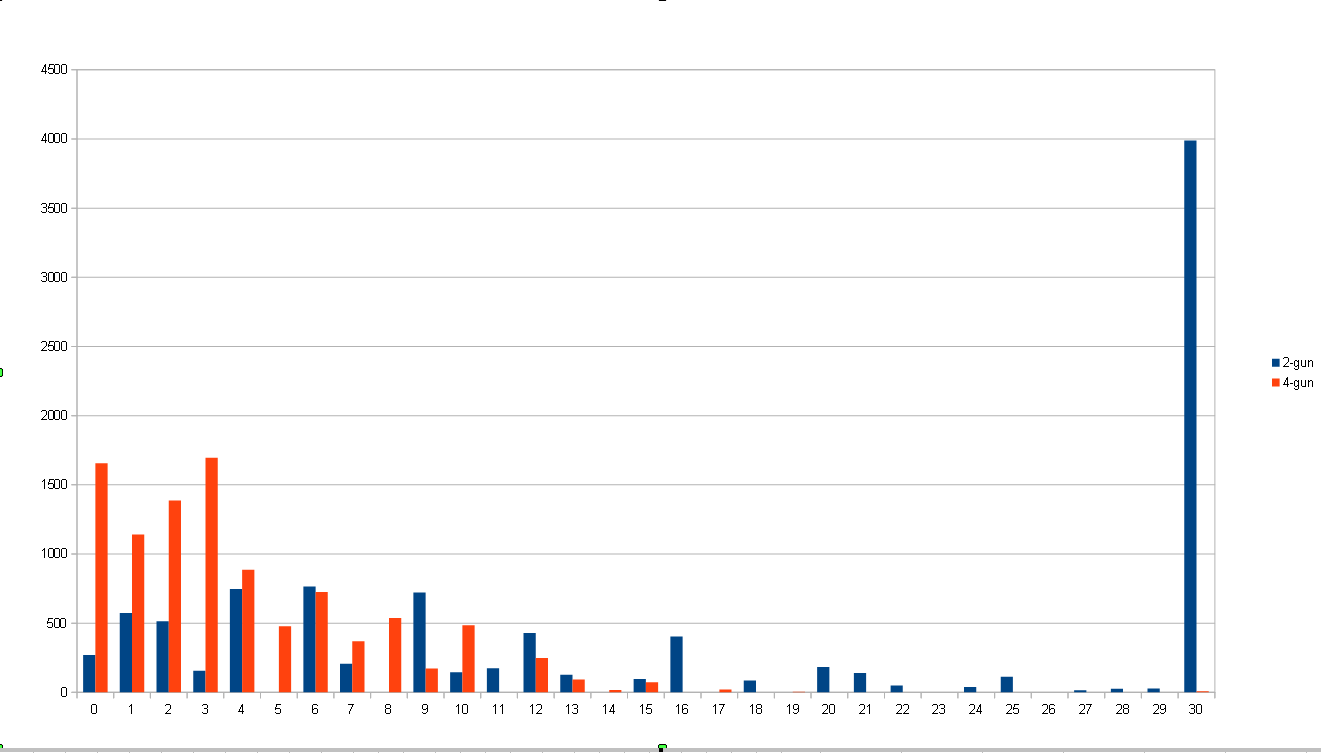
Dragons are similar to krakens against 4-gun ships - just slightly more threatening - but are absolutely lethal against 2-gun ships, where they have a ~40% chance to kill one outright from full health.
Sharks
Sharks have an encounter probability of 10%/speed, doubled if you are in deep water.
Sharks are not a particularly large threat to a ship. They roll d4-1 twice, and take the lowest result.
Sharks also have a certain interaction with Merfolk, see that entry for details.
Merfolk
There are two kinds of merfolk, Alexandrians and Atlanteans.
Alexandrians have a city in hex E16, and attack anyone within 2 hexes if it (with probability 20%/speed if you are 2 hexes away, 40%/speed if you are 1 hex away, or 60%/speed if you are on top of it).
Atlanteans have been migrating the ocean depths ever since their city fell. They move from F5 down to J13, up to N5, then back to F5. They will attack anyone in their hex or the adjacent hexes, with probability 60%/speed. At the time of your mission, they are in hex G7 (very close to your route to E8).
Encountering either type of Merfolk works like an accelerated version of being attacked by Harpies:
Each round, a wave of d6 Merfolk attack, you repel a number of them equal to your Guns, and you take damage equal to the remainder. Then, if the Merfolk failed to damage you, they give up for now and swim off (though they may attack again in future hexes). If they did at least 1 damage, they keep attacking.
Each type of Merfolk also has a gimmick:
Alexandrians defend themselves with Siren Storm Witches. After an encounter with Alexandrians finishes, regardless of its outcome, you are Storm-Cursed for the rest of the voyage. This triples your odds to encounter a Storm.
Atlanteans defend themselves with a giant robotic lobster trained Merfolk Sharkmasters. When you would encounter Atlanteans, you have a 50% chance to instead encounter their Sharkmasters. From your perspective, this looks like an encounter with Sharks (and behaves identically). However, after that encounter finishes, the trained Sharks follow you underwater and lead the Merfolk to you. For the rest of your voyage, your chance to encounter Atlantean Merfolk in their territory is tripled and you will always encounter the Merfolk (not the Sharks again).
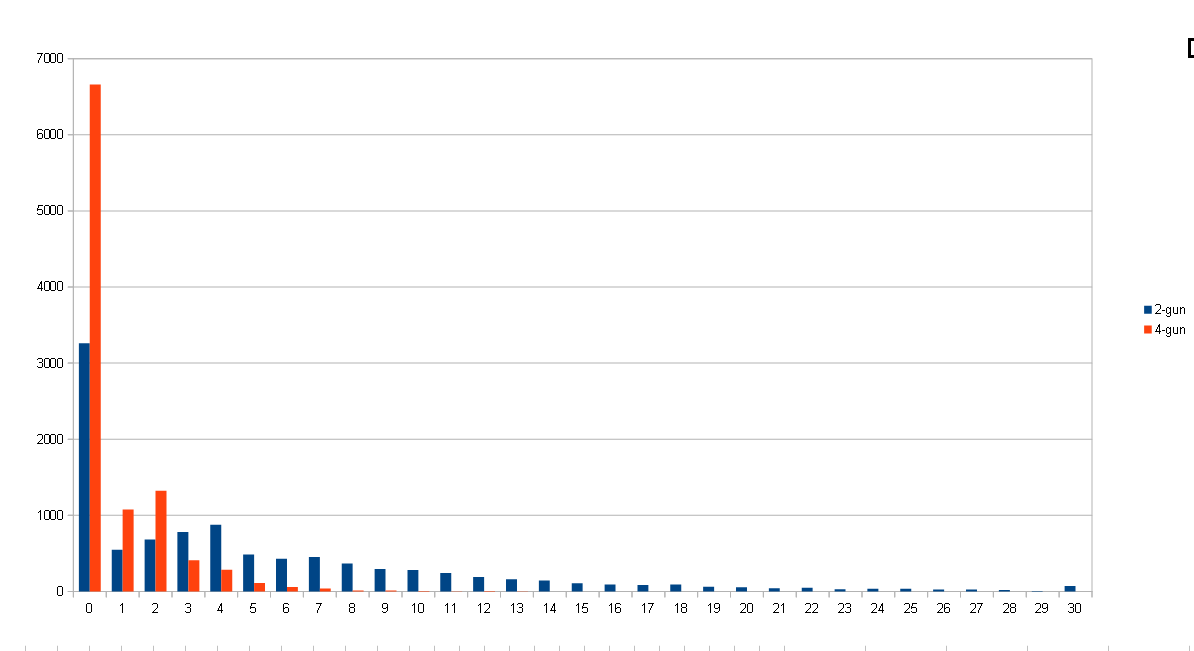
Merfolk damage is usually pretty low or zero, but has a long tail particularly for 2-gun ships.
Storm
You have a 7% chance to encounter a Storm in any given hex (potentially increased by Storm-Cursed, see Merfolk above).
A Storm has Severity 1d8. This is reduced by an amount equal to your Seamanship.
You take damage equal to the reduced Severity.
Then, if you are adjacent to land, you have a (damage taken*5%) chance to be dashed against rocks, taking an additional 2d6 damage (if Large) or 1d6 (if Small).
Hexes L6, L7 and M6 are where the Maelstrom forms when it activates. When you enter one of these hexes, you have a 10% chance to encounter the Maelstrom.
90% of ships that encounter the Maelstrom never see the vortex itself. They just get hit by the storms around its edges, which behave like a normal Storm.
10% of ships that encounter the Maelstrom are sucked into the vortex and instantly destroyed. No ship ever sees the vortex and lives to report it, so no ship has reported encountering the Maelstrom (though an unusual number of storms have been reported in those hexes).
Wyrd Majick Fyre
Sailors are versed neither in magic nor in natural sciences, and use this to describe two very different things:
St. Bert's Fire has a 1% chance to show up as a storm ends (in the immediate next hex you move to). It is mostly harmless, dealing 1d4-2 damage.
The Dark Warlock has a 40%/speed chance to blast a ship that passes adjacent to him. Most of the year, he is in his tower at J8. During summer, he retires to his Summer Palace at Q1.
When the Dark Warlock attacks, he rolls d6 to select which spell to use, and then casts that spell. He knows spells that do d4, d6, d8, d10, d12 and d20 damage.
Pirates
Pirates have a 12%/speed chance to be encountered in any hex. They are the most complicated encounter, and by far the most difficult to model.
Pirates run a ship with Hull 10, Guns 2 and Seamanship 1.
Each round:
- Both you and the pirates roll d6 + Seamanship.
- Whoever wins shoots the other, dealing d3 damage per Gun.
- On a tie, you both shoot the other.
- Then, if your % Hull remaining is > the pirate's, the pirate will retreat. (Pirates are not particularly interested in long slugfests with Navy vessels, they are hoping to prey on heavily damaged ones).
The Dread Pirate Captain Calamity operates out of Calamity's Cove, Hex M10. When you encounter pirates within 2 hexes of M10, you will instead encounter Captain Calamity, who has Hull 20, Guns 2 and Seamanship 2. (If Captain Calamity is forced to retreat, subsequent pirate encounters on that voyage will be regular pirates as she stops enforcing her territory while repairing her ship).
Pirate damage is quite complicated (depending on ship class, Seamanship and starting health). Here I'm using Seamanship 2 as an example:
Against full-hp ships, pirates deal reasonably constant damage by ship class - they will usually flee as soon as you hit them, so you take 0 damage, or occasionally 2d3, but only rarely more than that:
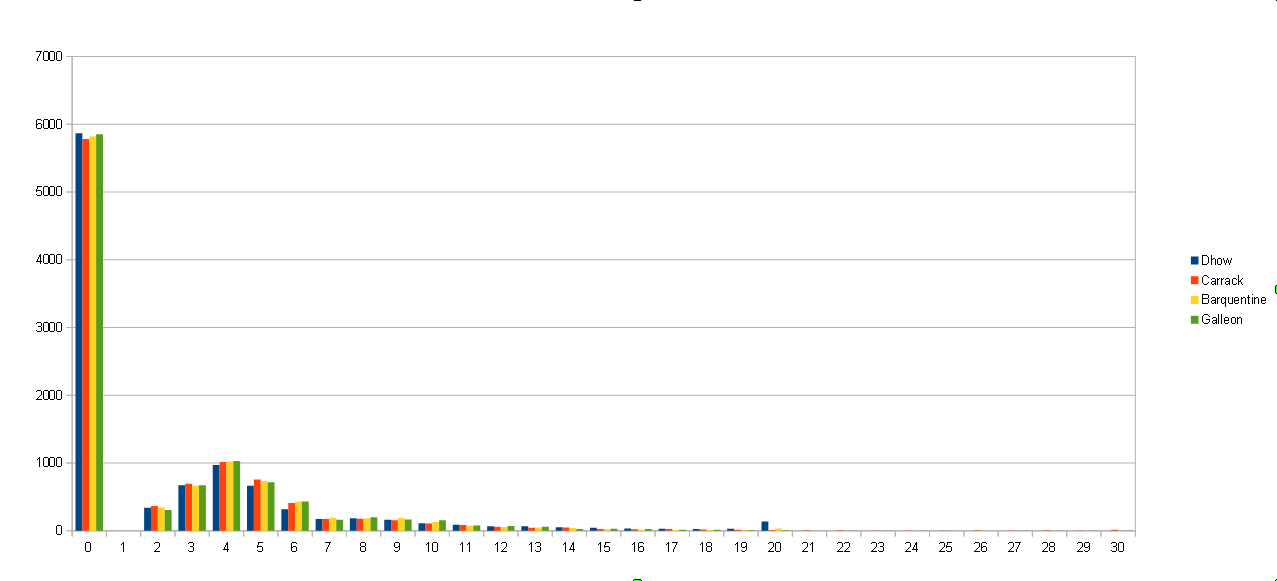
Against damaged ships, your ship class matters a lot more, as pirates will be more likely to stay and fight. Here's what happens if you start on half HP:
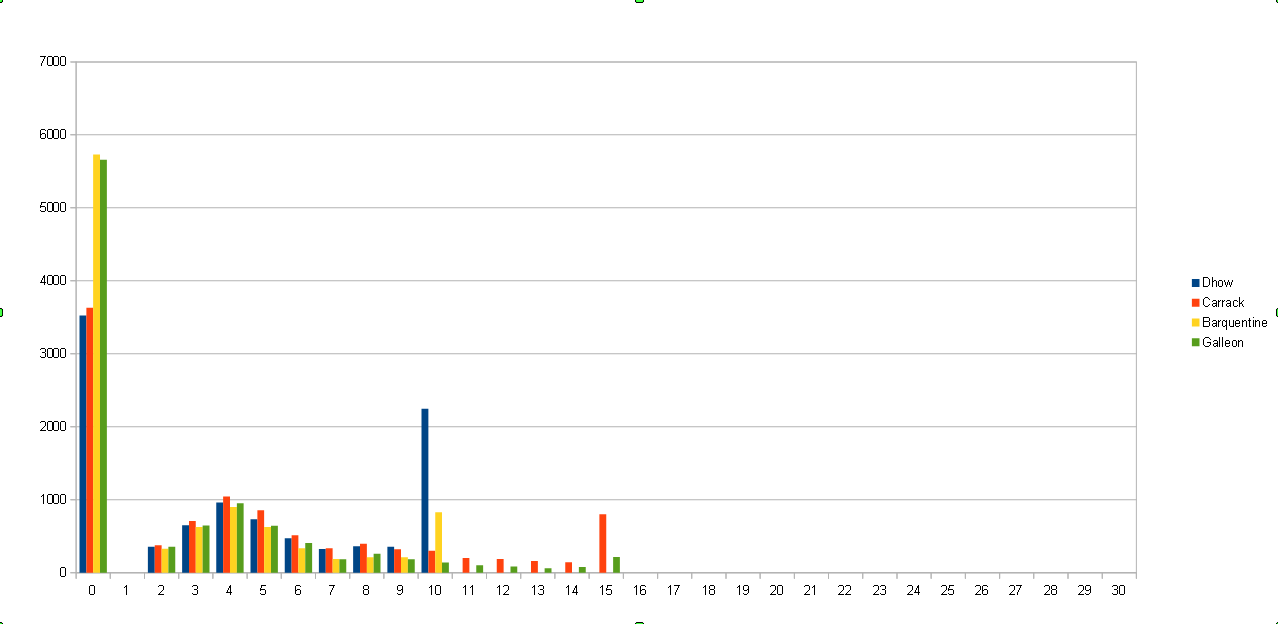
There's now noticeably more chance of pirates sticking in a fight with you until you die, since hitting them once is no longer necessarily enough to make them flee, particularly if you are in e.g. a Dhow.
STRATEGY
ROUTING
Routing has several goals:
- Avoid Shallow Water (reefs, run aground by storm) or Deep Water (krakens, extra sharks) wherever possible. Ideally you would spend your whole voyage at distance 2 from land.
- Avoid dangerous locations on the map.
- Keep your route as short as possible.
The optimal routes are:
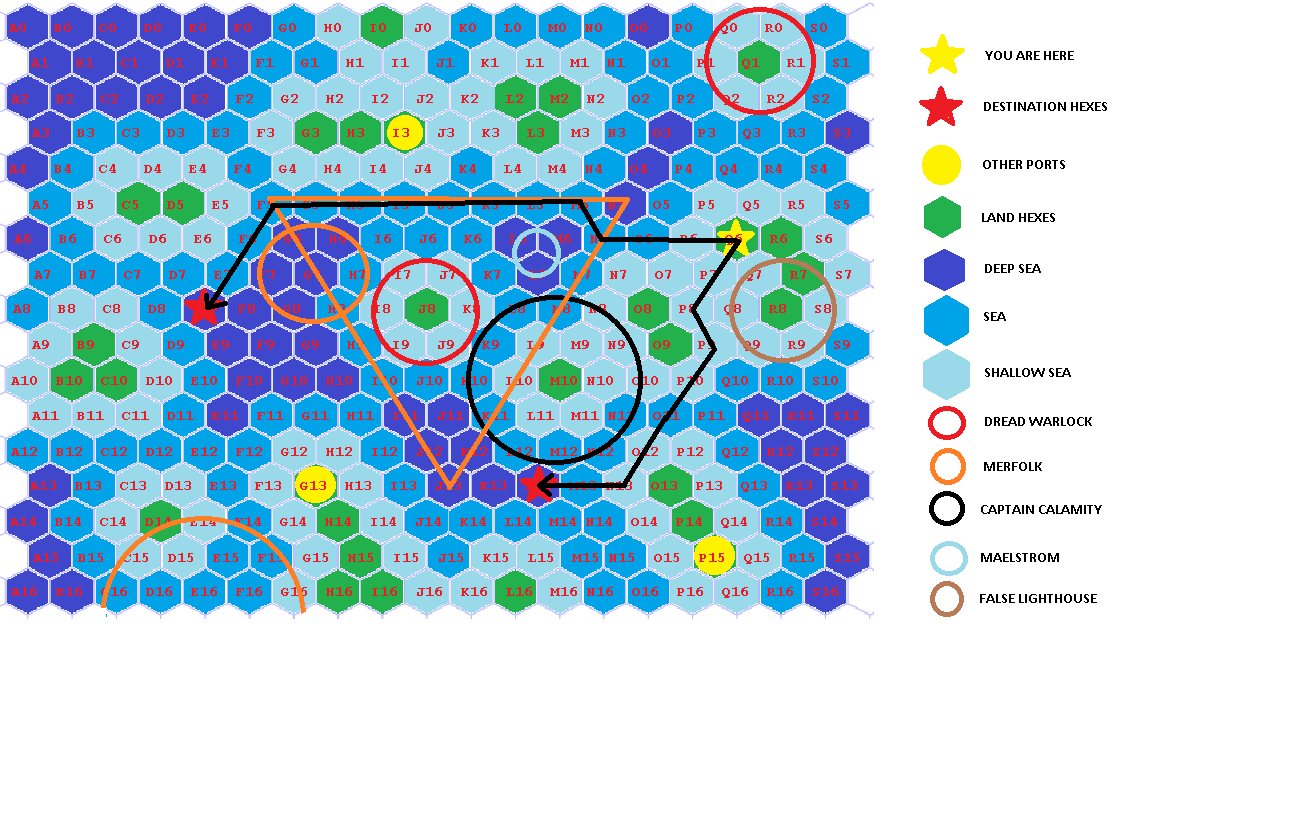
The optimal route to E8 is Q6-P6-O6-N6-M5-L5-K5-J5-I5-H5-G5-F5-F6-E7-E8.
This adds one additional hex to the shortest possible route, but in doing so avoids a lot of unneeded hazards: if you try to take the shortest possible route, you will encounter at minimum 3 extra deep water hexes including 1 Maelstrom hex, potentially some Shallow Water hexes as well, and 2 Merfolk hexes. Via this route, the only hex with any encounters above the minimum is your destination, which is a deep water hex.
The optimal route to L13 is Q6-P7-P8-P9-P10-O11-O12-N13-M13-L13.
This is a shorter route than the route to E8, but potentially more dangerous due to lots of unavoidable shallow water. We can, however, dodge Captain Calamity and the False Lighthouse.
A few notes on this route:
- The decision between hexes N11-N12 and O12-N13 is very close. Ultimately Captain Calamity ends up slightly more threatening than the extra shallow water for most ships.
- Several people avoided the shallow areas entirely, instead circling around via hexes L8 and K10. This route is better than the average Admiralty route, but not quite the optimal solution - it adds several hexes to your journey, and it spends a long time in Captain Calamity's territory. If you haven't got a Seamanship 1 captain (who are responsible for most of the high-damage values from reefs), you're better off just weathering the reefs in as high-HP and Seamanship a ship as you can find.
Success rates for various ship classes are in the table below. Note: all success rates below were Monte-Carlo derived rather than calculated.
Route to E8:
| Admiralty Route | Optimal Route | ||||
| Ship | Seamanship | Reach Objective | Return | Reach Objective | Return |
| Barquentine | 1 | 57.6% | 14.9% | 89.9% | 61.9% |
| 2 | 76.4% | 26.5% | 96.8% | 80.8% | |
| 3 | 86.7% | 37.5% | 99.1% | 92.2% | |
| Galleon | 1 | 53.4% | 6.7% | 82.5% | 38.6% |
| 2 | 76.2% | 15.6% | 95.9% | 68.4% | |
| 3 | 88.2% | 28.6% | 99.3% | 88.5% | |
| Carrack | 1 | 49.7% | 7.5% | 88.1% | 59.2% |
| 2 | 64.4% | 13.2% | 95.0% | 76.1% | |
| 3 | 71.7% | 17.9% | 96.3% | 85.0% | |
| Dhow | 1 | 41.5% | 4.5% | 78.2% | 39.6% |
| 2 | 48.5% | 6.5% | 89.0% | 55.7% | |
| 3 | 55.8% | 9.2% | 93.8% | 69.6% | |
Using the optimal route, a Barquentine and a Galleon are very similar in their chance to reach E8 (though the Barquentine is noticeably more likely to return safely, as Galleons have a tendency to suffer from attrition which hurts them more on long voyages). Carracks do noticeably worse, and Dhows worse still.
Route to L13:
| Admiralty Route | Optimal Route | ||||
| Admiralty Route | Optimal Route | ||||
| Ship | Seamanship | Reach Objective | Return | Reach Objective | Return |
| Barquentine | 1 | 65.5% | 29.5% | 80.8%* | 48.2%* |
| 2 | 86.9% | 56.1% | 93.5%* | 72.3%* | |
| 3 | 96.1% | 78.0% | 98.3%* | 88.2%* | |
| Galleon | 1 | 64.3% | 24.3% | 78.7%* | 38.3%* |
| 2 | 87.8% | 54.2% | 95.4% | 67.5% | |
| 3 | 97.4% | 80.9% | 99.3% | 88.6% | |
| Carrack | 1 | 73.7% | 37.5% | 84.8%* | 53.7%* |
| 2 | 89.7% | 63.7% | 95.5% | 72.0% | |
| 3 | 95.6% | 79.2% | 97.9% | 86.2% | |
| Dhow | 1 | 76.2% | 46.4% | 85.1% | 52.3% |
| 2 | 86.4% | 59.9% | 93.4% | 68.7% | |
| 3 | 92.7% | 72.5% | 96.4% | 78.9% | |
*Galleons and Carracks at 1 Seamanship, and Barquentines at any Seamanship, have a hard enough time with Reefs that their optimal route is a little different, and they are better off deviating into Calamity's waters e.g. in hexes N11-N12 rather than going through more shallow water.
A Galleon is the best ship for this route, with a Carrack very close (or even better at low Seamanship). A Barquentine does not handle reefs well, and a Dhow is still pretty bad (though it is much closer here).
SHIP SELECTION
There are a few factors to consider for ship selection:
- You do not want a Dhow.
- You do not want a ship that is currently damaged (due to inadequate time to repair).
- You want as high a Seamanship as possible, and particularly want to avoid Seamanship 1 (which is unusually bad). Avoiding Seamanship 1 can be done reliably by not using Noble captains - distinguishing Seamanship 2 and 3 is very hard and not always possible.
- You would like to select the correct ship class for each voyage:
- The voyage to E8 goes through clear hexes, but is very long, so the main threat is e.g. random Dragons. You want a Barquentine (ideal) or a Galleon (nearly as good) for this route, while a Carrack is not great (and a Dhow is dreadful).
- The voyage to L13 goes through lots of shallow water, where the main threat is e.g. reefs. Here a Barquentine is very bad (actually as bad as a Dhow!) while a Carrack is very good (almost as good as a Galleon).
I didn't interfere with the RNG for ships available in port - you just have the ships that happened to be in port at the time, which are :
| Ship Name | Ship Type | Captain Name | Weeks Since Last Voyage | Seamanship | Current Hull |
| Bloody Diamond | Barquentine | Angus MacDougal | 8 | 2 | 20/20 |
| Orange Falcon | Galleon | Brandon Buchanan | 7 | 3 | 30/30 |
| Red Pearl | Dhow | Brandon O'Malley | 6 | 3 | 20/20 |
| Green Heart | Dhow | Baron Heinrich von Reinhardt | 6 | 2 | 20/20 |
| Purple Heart | Dhow | Rick O'Neal | 5 | 2 | 20/20 |
| Saucy Heart | Barquentine | Erin Aubrey | 4 | 3 | 20/20 |
| Rusty Heart | Barquentine | Sir Gerhart von Zelig | 4 | 1 | 20/20 |
| Mopey Diamond | Carrack | Conall MacDougal | 3 | 3 | 14/30 |
| Scurvy Hind | Dhow | Dyllon Keating | 3 | 3 | 20/20 |
| Mopey Tortoise | Barquentine | Brandon O'Neal | 3 | 3 | 9/20 |
| Red Duck | Dhow | Conor Callahan | 3 | 3 | 20/20 |
| Scurvy Swan | Carrack | Seamus Reagan | 2 | 2 | 30/30 |
| Silver Duck | Carrack | Jack Keating | 2 | 3 | 27/30 |
| Mopey Hind | Barquentine | Angus MacDougal | 1 | 3 | 11/20 |
| White Hind | Dhow | Conor O'Connell | 1 | 2 | 20/20 |
| Bloody Bottom | Carrack | Lord Friedrich von Walderdorf | 1 | 1 | 30/30 |
| Bloody Swan | Carrack | Count Manfred von Konig | 1 | 1 | 29/30 |
The Orange Falcon is a full-Hull, Seamanship 3 Galleon that is an excellent ship to choose. You can improve on the Bloody Diamond by instead choosing the Saucy Heart (which has seamanship 3), but trying for this is risky - it's hard to identify high Seamanship, and you take the risk of a damaged ship (like the Mopey Tortoise) or a Seamanship 1 captain (like the Rusty Heart).
Optimal strategy is to send the Orange Falcon to Hex L13 via Q6-P7-P8-P9-P10-O11-O12-N13-M13-L13, and the Saucy Heart to Hex E8 via Q6-P6-O6-N6-M5-L5-K5-J5-I5-H5-G5-F5-F6-E7-E8.
LEADERBOARD
Submitted performances are:
| Route to E8 | Route to L13 | Overall | |||||
| Player | Commands | Reach Obj. | Return | Reach Obj. | Return | Both Obj. | # saved |
| Optimal play | Saucy Heart to E8 via Q6-P6-O6-N6-M5-L5-K5-J5-I5-H5-G5-F5-F6-E7-E8, Orange Falcon to L13 via Q6-P7-P8-P9-P10-O11-O12-N13-M13-L13 | 99.1% | 92.2% | 99.3% | 88.6% | 98.4% | 1.808 |
| simon | Bloody Diamond to E8 via Q6-P6-O6-N6-M5-L5-K5-J5-I5-H5-G5-F5-F6-E7-E8; Saucy Heart to L13 via Q6-P6-O6-N6-M7-M8-L8-K9-K10-K11-L12-L13 | 96.8% | 80.8% | 97.6% | 89.8% | 94.5% | 1.706 |
| abstractapplic | Orange Falcon to E8 via Q6-P6-O6-N6-M5-L5-K5-J5-I5-H5-G5-F5-F6-E7-E8; Bloody Diamond to L13 via Q6-P6-O6-N6-M7-M8-L8-K9-K10-K11-L12-L13 | 99.3% | 88.5% | 92.8% | 76.5% | 92.2% | 1.650 |
The Admiralty | Bloody Diamond and Orange Falcon choose between those destinations with random routes | 82.3% | 27.6% | 92.2% | 68.5% | 75.5% | 0.961 |
| Measure | Red Duck to E8 via Q6-P7-Q8-Q9-Q10-P11-O11-N11-N12-M13-M14-L14-K14-J14-I14-H13-H12-G12-F11-F10-E9-E8; Scurvy Hind to L13 via Q6-P7-Q8-Q9-Q10-P11-O11-N11-N12-M13-L13 | 65.0% | 19.1% | 93.4% | 72.5% | 60.7% | 0.916 |
| Yonge | Mopey Diamond to E8 via Q6-P6-O6-N6-M5-L5-K5-K6-J6-I6-H7-H8-G9-G10-F10-E9-E8; Orange Falcon to L13 via Q6-P7-P8-P9-P10-O11-N11-N12-M13-L13 | 35.7% | 4.4% | 98.8% | 88.6% | 35.3% | 0.930 |
Thank you to everyone who submitted an answer! My congratulations to everyone who managed to outperform the Admiralty, and my condolences to those who got tripped up (usually in ship selection) and did not.
For any future players who want to test their performance, you can run a line like this one in the code to simulate a given ship on a given route:
simulate_test('Q6-P6-O6-N6-M7-M8-L8-K9-K10-K11-L12-L13', 'Saucy Heart')
or if you aren't familiar with the code, DM me and I can run for you.
THE LARGE SECRET
There was one major secret hidden in the data - what the Admiralty's mission was, and the Hidden Bonus Objective related to it.
The Admiralty has discovered the Dark Warlock's tower on J8, and the Admiralty Mage Corps is trying to arrange a ritual to freeze his tower in time (and trap him with it). To do this, they need mages arranged in six points around him: your two destinations, plus G3, L3, O8 and G13.
Four of those points are land. Last week, the Admiralty overrode the usual export and scouting voyages from Eastmarch and instead sent out four ships, carrying expendable mages and the devices to focus the ritual, to those four places. Several of these voyages looked very strange in the logs:
- One was a 'scouting' voyage that traveled only 2 hexes to O7 (in order to drop off mages at O8). This is shorter than any other scouting voyage has ever been.
- Two were listed as carrying Magefruit in the logs. However:
- One of these was journeying to Westengard, where Magefruit is never normally exported to (since Westengard is already a Magefruit producer).
- Neither of these voyages was attacked by Harpies, which is improbable for voyages carrying Magefruit.
- One was listed as travelling to Norwatch. However, while in Hex H4 (not on its planned route to Norwatch) unloading mages into Hex G3, it hit a reef. On arriving in Norwatch, the Captain disclosed this damage to the Admiralty, then realized his route wasn't meant to have taken him into that hex, tried to backtrack, realized he was sounding more suspicious, and stammered out something. The ensuing confusion led to the damage being put down as 5% rather than 4%, a damage value his Carrack can never actually take.
Now that those four voyages have arrived as planned, the Admiralty wants to send two ships to the two sea locations in order to perform the ritual.
Sadly for the Admiralty, they have not discovered the Dark Warlock's Summer Palace, and do not know that he has moved up there for the summer. As such, they're about to perform their ritual to freeze his Tower in time while he is not in it. Oops. Still, at least this part wasn't your fault.
THOUGHTS AND FEEDBACK REQUEST
I tried to make this scenario more involved than past D&D.Sci scenarios, and to ensure that there were multiple things you could figure out rather than just one way to succeed. Given that this challenge ended up with noticeably fewer answers than previous ones, it looks like I went a bit too far with the complexity. Interested in feedback on this. What level of complexity do you want to see? Were you planning to do this challenge until you got scared off/gave up? What did you like and what did you dislike about this scenario?
Several people did end up tricked by sneaky things in the dataset, but on the whole I think they were reasonably realistic elements that felt pretty fair to me. (Why do ships wait in port for 5 weeks? To repair damage on them. Why do Dhows survive so well? Because the Admiralty sends small shallow-water ships on short shallow-water voyages.) Particular congratulations in this regard to abstractapplic, who couldn't figure out why ships waited in port for 5 weeks, but figured there needed to be some reason and played it safe with the Admiralty-recommended ships'.
Thanks for playing!
13 comments
Comments sorted by top scores.
comment by SarahNibs (GuySrinivasan) · 2021-09-09T15:50:37.968Z · LW(p) · GW(p)
I tried to make this scenario more involved than past D&D.Sci scenarios, and to ensure that there were multiple things you could figure out rather than just one way to succeed. Given that this challenge ended up with noticeably fewer answers than previous ones, it looks like I went a bit too far with the complexity. Interested in feedback on this. What level of complexity do you want to see? Were you planning to do this challenge until you got scared off/gave up? What did you like and what did you dislike about this scenario?
I have participated in (almost?) all past D&D.Sci scenarios, but not this one. Here are the reasons:
- complexity - it was very obvious upfront that spending "a little" time would not feel satisfying to me (whether that's true or not I don't know). In particular I guessed that while there were plenty of patterns to find, the true satisfying thing (again, for me) here would be tackling the survivorship bias, which didn't seem very tractable without lots of prior work
- activation energy - I didn't really reach a point at any time when I actually felt motivated to go get the data into a nicely analyzable state. Contributors: 2D data, hex vs square, routes. (some things were nicely analyzable from the start; I didn't want to spend time unless I knew I could look at everything though)
- other commitments - I said I'd write my own, so I've already got D&D.Sci [stuff] going on
- other other commitments - happened to have a lot going on, exacerbating all of the above
My ideal complexity is probably just barely above the average past complexity. A note: I have written many puzzles for many puzzle events, and seen others write, and an extremely common mistake is to add complexity until it feels about right for you, but since you're the one writing the puzzle and have internalized a lot of the inferences and approaches already, you misjudge how complex it actually is and actually feels to people not already involved with the puzzle. And unless you're careful about getting feedback, you might not even notice, because some people will engage and get past the activation energy hump and love it and tell you it was great. Survivorship bias. :) These aren't puzzles, but they feel to me a lot like "data analysis puzzles".
All that said, thank you for making this! It looks like several people did engage fairly deeply, and if not for commitments I might well have been among them! I enjoyed most of your choices, after reading the solution, and those that I didn't, I think I'd root-cause to "adds more complexity". And reading yours caused me to finalize a decision I was making for my own in favor of the way that makes the data easier to "just start using".
Replies from: aphyer↑ comment by aphyer · 2021-09-09T21:48:00.713Z · LW(p) · GW(p)
If I cannot manage to serve as a shining example, at least I can serve as a cautionary tale.
Replies from: GuySrinivasan↑ comment by SarahNibs (GuySrinivasan) · 2021-09-10T03:11:39.727Z · LW(p) · GW(p)
Both IMO. It takes guts and grit to create and clean up something like this and you did it.
comment by simon · 2021-09-10T06:46:49.130Z · LW(p) · GW(p)
FWIW I had fun, or at least I remember it that way (I could have suppressed memory of frustrations). I do think I prefer things that are more complicated, or have "secrets", in terms of the underlying dynamics. As you noted in the original post, even if we don't find everything we can still find some things.
I was still planning on doing more analysis but was busy the last few days. (I also made a mistake where I tried to separate the different merfolk areas with a column and row check and noticed afterwards that only the column check had worked, which provided a tiny, but maybe not insignificant psychological activation barrier to continuing.)
Where complication is maybe less desirable is in terms of the data we are supplied. Even so, while I didn't look at, e.g. captains or voyage purpose, I don't feel it was a detriment to my enjoyment of the scenario and I could have looked at them if I had more time.
One thing that did provide some frustration at the start was separating the planned voyages into columns. Text-to-columns did not work correctly in LibreOffice Calc until I made all the hexes the same number of characters. In Excel on the other hand it immediately worked with dash as a separator. (I ended up switching back to LibreOffice Calc again though when I couldn't immediately figure out how to use regular expressions in Excel.)
Edit: I agree with abstractapplic that I'd prefer complicated dynamics to arise from simple rules where possible, but also don't know if that's practical when setting up a puzzle. I am fine though if they are not simple - in real life things are usually not simple. And, in a sense, extra complications are kind of like random noise when you don't figure them out, and are fun-to-deduce regularities to the extent you do. Which is OK (or good) either way.
comment by abstractapplic · 2021-09-09T21:26:37.080Z · LW(p) · GW(p)
Thank you again for making this; it’s been enlightening to play one of these for a change.
Reflections on my attempt:
It appears my obliviousness to Encounter Frequency concerns didn’t damage my plans as much as I feared. It’s hard to say how much of my better-than-random result was down to good analysis vs careful management of unknowns vs sheer good luck: if damage from Pirates and Harpies weren’t dependent on things that happened earlier in the voyage (an effect to which I was also oblivious), or if the Atlanteans had been in a different position on their route (a journey to which I was also also oblivious) or if the Maelstrom (a phenomenon to which I was also also also oblivious) had happened to be along either of my chosen paths, I might not be looking quite so clever right now.
In retrospect, once I’d found the skeleton key of “the Admirality treat every ship that isn’t a Dhow as interchangeable, so their ability to survive journeys is an unbiased estimator”, I could and should have gotten much more mileage out of it. For example, it could have easily let me infer that nobility mattered and that Scottish-sounding names (conditional on non-nobility) didn’t. I guess the lesson here is “if you run into a perfect regularity while working on a wicked problem, make sure you mine everything you can out of it”.
(. . . well, that and “your mental algorithms have a tendency to overfit”. While some of my inferences and suspicions were confirmed, it’s disquieting how many of them ended up not holding water.)
Reflections on the challenge:
For what it’s worth, I very much appreciated this scenario’s complexity while investigating it. The ability to thrive in a system of arbitrary rules you’ll never fully understand is an important life skill known as ‘living’; I’m glad of the opportunity to practice without risking anything in reality.
Insofar as the level of detail bothered me, it was while reading the ruleset afterwards. I’d hoped – naively – that I’d get to see the hidden simplicities that had emergently created this complexity, but with few exceptions (turns out simon was right about where kraken live) it turned out to be epicycles all the way down. I don’t know how or if it’s possible to get the former benefit without the latter cost.
comment by Measure · 2021-09-10T00:52:22.555Z · LW(p) · GW(p)
I had a lot of fun with this one. There were a lot of things I missed, and I could have spent a lot longer looking for patterns if I'd had more spare time. The 2d + time meant a lot of room to search, but this was partially offset by sensible real-world structure (e.g. northern icebergs, reefs near land, etc.) I agree with Yonge that this level of complexity was nice for a change but would be a bit excessive as the norm. I used a combination of Excel and Python and didn't have as much trouble with the data format as others seem to have had.
As far as my strategy, I started with routes that avoided previously dangerous hexes (my eastern route was a bit long, but I was hoping that the two ships sailing together could support each other or at least increase the joint probability by correlating encounters). I missed the migrating merfolk, so I avoided the shorter northern route.
I didn't spend as much time selecting ships. I noticed that Dhows had better survival rates but missed that they were assigned easier voyages. I didn't notice the captain effect on reef encounter rate and chose Dhows to avoid the high per-encounter damage given that I had a lot of unavoidable reefs on my routes. I chose ships that had a long history of successful voyages and did manage to get two seamanship-3 captains.
comment by Yonge · 2021-09-09T22:07:26.915Z · LW(p) · GW(p)
This was my favourite dand sci problem so far, and I would have spent longer looking at it if it hadn't coincided with a period when I had less free time than usual.
The one niggle I had with this is that the data wasn't in the most user friendly format, and a significant fraction of the time I spent on this was used munging the data into a more useable format. Maybe a useful exercise for problems of this complexity would be for the author to attempt to solve it using just the given data, and adjust it accordingly?
Making every problem this complex feels like it would be taking things too far, but I would like the occasional one like it.
comment by J Bostock (Jemist) · 2021-09-09T17:41:31.504Z · LW(p) · GW(p)
Though the task seemed really interesting, I didn't even enter an answer as I lost interest after some preliminary analysis. Almost all of these applied to me too. The data was presented in an excel-unfriendly way and as I'm currently settling into a new job I didn't have the energy to code a python script to trawl through the data. I suspect the participation was weighted towards those with more experience of statistical languages. A better presentation might have been a log of all squares ships had planned to go through with encounters listed there (with ??? for sunk ships) or something like that. I wish I'd had the time to participate properly as I do love doing D&D.sci when I can. Other than that I agree with most of GuySrinivasan's points.
Also: as GuySrinivasan is also planning to run one of these might I suggest the formation of a community rota for those interested? As my commitments are about to shrink I'd be interested in doing one at some point and it might help to avoid people "scooping" each other.
Replies from: GuySrinivasan↑ comment by SarahNibs (GuySrinivasan) · 2021-09-09T19:59:27.513Z · LW(p) · GW(p)
https://docs.google.com/spreadsheets/d/1EDanxmrtgunqLq7BclqEOt79Ce7uJpmGULvZICYVdC8/edit?usp=sharing
Like this? If people viewing these comments don't have a better plan, I'll PM the link to everyone I see on past D&D.Sci posts. Feel free to edit however you'd like.
comment by abstractapplic · 2021-09-10T00:35:27.383Z · LW(p) · GW(p)
You may want to include a link to the challenge in this post, so people seeing it on the frontpage know what you're referring to.
Replies from: aphyer